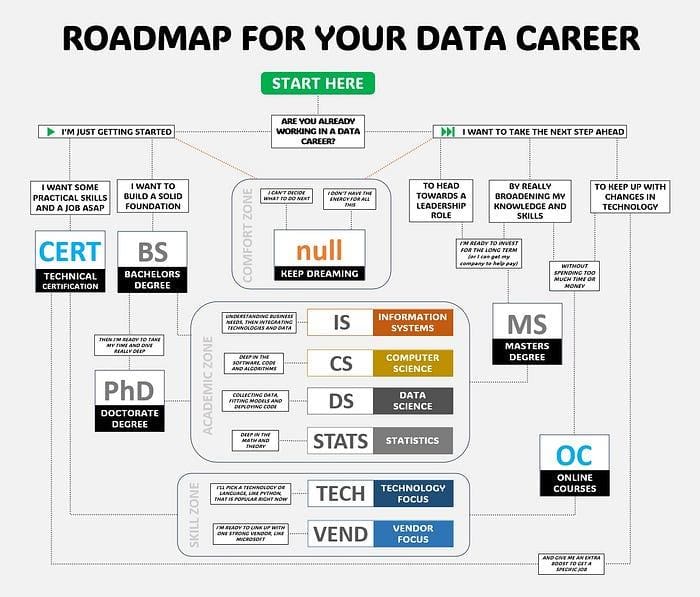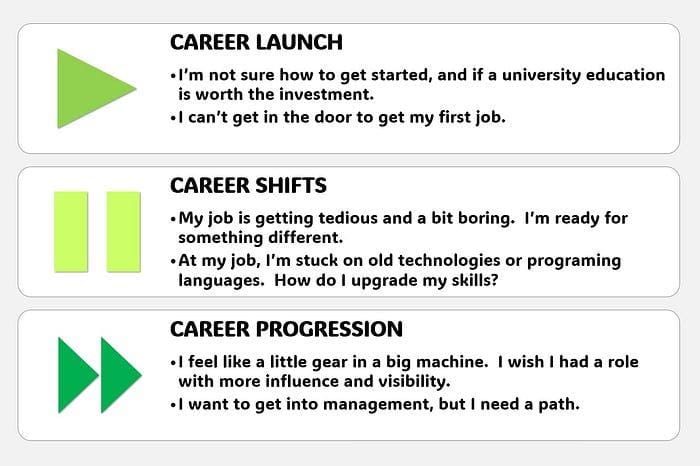Careers in data are not for everyone — you need patience to work with evolving business, security, and infrastructure requirements and a good amount of mental endurance to work with endless data issues and changes. But they can also be the most interesting jobs in the world. Every month has a new puzzle to put together in a new way, and new technologies and innovations keep the field continually new. Data careers are also going to be even more vital as AI demands larger and more diverse training datasets.
There is no one way to enter or continue a career in data, but let’s start with a reference roadmap that will serve as the framework for this article, and then we can talk about the decision points and phases that you will find along the way. Whether you are a data scientist, data engineer, software developer, business analyst, or infrastructure/security specialist, these paths could apply to you.

Roadmap to a Data Career
Next, before we explore the roadmap, let’s look at some of the reasons that you might be reading this article. Do any of these common complaints match your current experience?
- “I’m not sure how to get started, and if a university education is worth the investment.”
- “I can’t get in the door to get my first job.”
- “My job is getting tedious and a bit boring. I’m ready for something different.”
- “At my job, I’m stuck on old technologies or programing languages. How do I upgrade my skills?”
- “I feel like a little gear in a big machine. I wish I had a role with more influence and visibility.”
- “I want to get into management, but I need a path.”
We can group those concerns into the following career phases:

Data professional concerns by career phase.
In the roadmap, we can find key questions and considerations for each of the phases.
Your perspective on how to launch a career will be affected by a variety of factors.
- Your family culture related to formal education and careers — Did your parents go to college?
- Resources and preparation — Do you have financial help? How well did you do in high school?
- Economic conditions — When was the last recession? How high is unemployment?
- Career orientation — How do you define the right work/life balance? How driven are you to climb the promotion ladder?
- Interest in theory versus application — Do you gravitate towards practical technical skills that you can use immediately? Or would you rather dive deep into computer science algorithms or statistics theory?
Based on those factors, you may decide that spending 3 months and a few hundred dollars on a few certifications in a practical, technical area like Microsoft Entra ID is right for you. On the other end of the spectrum, you may decide that 8 years to get a Bachelor’s degree and PhD in Statistics fits your aspirations. There are dozens of combinations of paths, but the main question is whether you want to make the effort to build a broad, solid foundation or if you feel like you have limited time and money and need a job ASAP.
In the launch phase, it is important to research the future roles that appeal to you and then study the job descriptions for those positions. Based on the job descriptions, you can reverse engineer the steps that you will need to take to get there. What are the the skills, programming languages, and experience needed for those roles? With those items in mind, you can create goals to upskill in those specific areas.
Regardless of your path, one of the biggest challenges is to get in the first door at a company in your target field. Having taken some random online courses won’t help in this situation. You need to find a way to add to your resume some clear credentials, an official degree, or documented accomplishments in a recognized project-experience forum like Kaggle. As you select between your options, take a close look at completion rates at the various programs and make sure that you feel like you can fully commit to finishing before you make any payments or go into debt
Finally, be creative in how you expand your network. Join a school technology club; attend meet-ups with a local tech group; look for an upcoming industry conference with networking events. And if you have attended a school with a career center, become best friends with everyone in the office and ask them for help to find the open positions that other people might overlook. You might find a niche position, inside track, or unadvertised opening, that won’t have 500 other online applicants.
As time passes, you will need to be prepared to shift and reskill as your company changes directions, your job function is reassigned, or you move to a new job at a new company. In the roadmap, these minor shifts are referred to as needing to “take the next step.”
If those steps require you to work with new technologies or learn a new skill that is adjacent to your current skillset, then online courses are an excellent way to help navigate the shifts.
Online courses, such as those offered by DataCamp or Pluralsight, are practical, targeted, and cost effective, and they can be assembled into a various certifications. The big challenge with these courses, though, is that their completion rate is abysmal (often under 10%). If your company offers training funds, or if you can negotiate for funds, make sure to use those funds wisely and complete your courses.
Career progression is often a bigger challenge for technical data professionals than managing career shifts. If you decide to seek promotion beyond the senior analyst/developer/engineer level, the challenges come in three forms:
– The skills that make a great developer, analyst or engineer are different than those needed to be a great team lead or manager (i.e. what got you here won’t get you there)
– The business awareness and context for management work is difficult to acquire while doing technical data work
– The network of relationships you have developed as an individual contributor is different than the network you will need as a manager.
A formal university master’s degree is a great way to solve all three of those issues. New masters programs are designed to be shorter, more targeted, and more flexible for the time constraints of people with a full-time job. Online degrees are not as effective at building a network of relationships, but you might decide that the flexibility is worth the tradeoff.
At the center of the roadmap is the comfort zone labeled with “null.” Unfortunately, this is where a lot of us end up. We let our manager decide which skills or projects we are assigned to develop. We let company layoffs determine the timing of our next career shift. Or we look at options to upgrade our career, but decide they are too intimidating or expensive.
Your career is going to last 40–45 years; isn’t it worth being proactive about the path we want to take?
Stan Pugsley is a freelance data engineering and analytics consultant based in Salt Lake City, UT. He is also a lecturer at the University of Utah Eccles School of Business. You can reach the author via email.